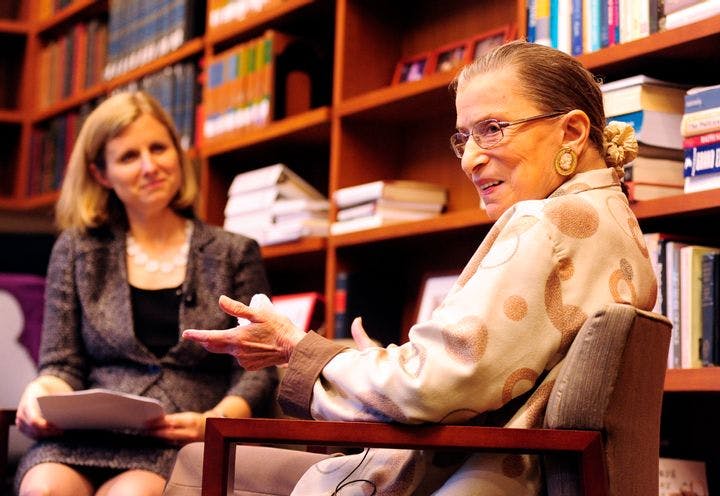Spring 2009
Legal Limits
– Alexandra Vacroux
Alexandra Vacroux on women's legal rights.
Equal is the story of the resolute and plucky lawyers (many female, some male) who tackled one obstacle after another to reverse gender-based discrimination in the United States. Fred Strebeigh, a writer who teaches nonfiction at Yale, draws us into his tale by tracing the careers and accomplishments of U.S. Supreme Court justices Ruth Bader Ginsburg and Sandra Day O’Connor, feminist legal scholar Catharine MacKinnon, and many lesser-known but no less-determined women. All the action takes place in the few short decades since American law schools began admitting women in more than token numbers.
Strebeigh begins with the fight against rules that arbitrarily preferred men over women in the allocation of government rights and benefits. As a law professor at Rutgers and then Columbia, Ginsburg worked with a few close allies to advance cases that strategically undermined the Supreme Court’s interpretation of the Fourteenth Amendment’s equal protection clause. Since the amendment’s enactment in 1868, the Court had not subjected the charge of discrimination against women to the same scrutiny as a charge of racial discrimination. Only as a Supreme Court justice herself did Ginsburg finally succeed in nudging the Court to apply “skeptical scrutiny”—though still not the highest standard of “strict scrutiny”—to laws that may violate the U.S. Constitution’s promise of “equal protection of the laws” for women. In 1996, in United States v. Virginia, she wrote the majority opinion finding that the Fourteenth Amendment required the exclusive Virginia Military Institute to admit women.
Elsewhere, Strebeigh examines the struggles to open law schools and the legal profession to women, to ensure that pregnant women were not discriminated against, and to codify sexual harassment and domestic violence as crimes. The narrative of incremental legal change is enlivened by Strebeigh’s gift for fleshing out the human drama underlying key cases. His extensive interviews with those who prepared and argued those cases, as well as the use of Court and personal archives, allow him to piece together some of the personal dynamics on the Supreme Court.
Strebeigh is particularly good at dramatizing how the Supreme Court works, and how it vies with Congress to shape the law. For example, he devotes a chapter to the 1976 case General Electric Co. v. Gilbert, which arose because GE (which employed 100,000 women) excluded conditions relating to pregnancy from its disability plan, in part because of the cost. In the words of GE president Gerard Swope, “Women did not recognize the responsibilities of life, for they probably were hoping to get married soon and leave the company.” In the Court’s majority opinion, William Rehnquist wrote that the 1964 Civil Rights Act did not define the word “discrimination” in a way that made it clearly illegal to discriminate against pregnant women. An outraged Congress quickly passed what became the Pregnancy Discrimination Act, which President Jimmy Carter signed in 1978.
The parallel between the struggle for equality for people of color and efforts to apply civil rights protections to women—which came later—runs through Strebeigh’s account. President John F. Kennedy signed the Equal Pay Act of 1963 just before introducing a draft of the legislation that would become the 1964 Civil Rights Act. The draft only prohibited discrimination on the basis of race, color, religion, or national origin. A Virginia congressman proposed adding “sex”—he said later, “as a joke”—as an additional category in Title VII, the section that concerned employment, hoping this would kill the bill. It didn’t. But enforcement was another matter: For years, the newly created Equal Employment Opportunity Commission dealt grudgingly with cases of gender discrimination. Susan Deller Ross, a lawyer who joined the EEOC in 1970 to work on women’s rights, recalls being greeted by a female colleague who grumbled bitterly, “I hear you’re one of those feminists.”
Equal is a sobering reminder that these battles were fought within the lifetime of any woman older than 30. In the absence of a ratified constitutional amendment guaranteeing women equal rights, recognition that women are entitled to the same legal protections as men has emerged gradually. This book generates a genuine appreciation for the legal entrepreneurs who fought long and hard to make possible the careers of many a professional woman, including this one.
* * *
Alexandra Vacroux is a senior scholar at the Woodrow Wilson Center.
Reviewed: Equal: Women Reshape American Law by Fred Strebeigh, Norton, 582 pp, 2009.
Photo courtesy of Stanford Law
Up next in this issue
